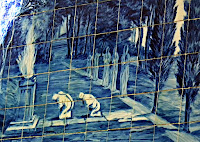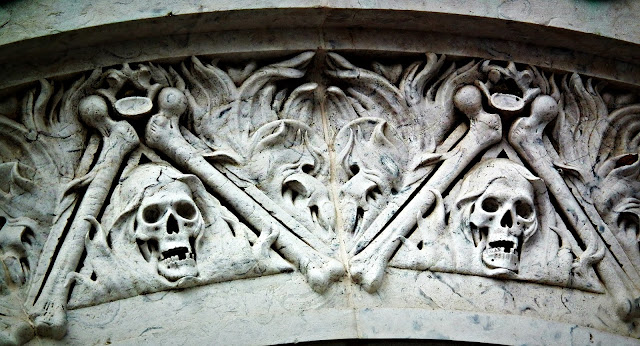For no good reason I can’t help
feeling slightly guilty for deserting, even temporarily, the subject of (dead)
London and Londoners. The idea of a sister blog called the Lisbon Dead has appealed to me for some time but I barely have time
for one blog and I’m just kidding myself if I think I’ll ever manage to keep up
with two. So I may as well bow to the inevitable and allow myself to stray off-piste;
what follows is the London Dead on holiday.
This post is an early, and inferior, version of something I wrote for
Loren Rhoads ‘Cemetery Travel’ blog. Loren prodded me into writing a better post
by asking clever and pertinent questions and in gratitude I will leave the
resulting piece on her blog and use the original version on my own.
My wife is Portuguese and still
has family in Lisbon. When my sister in law moved to a new apartment in the high-rise
suburb of Olaias I was intrigued by the large hillside cemetery I could see
from her 8th floor windows. It
was the cemitério do Alto de São João I was told when I asked. It didn’t look too far away and I promised
myself that I would go and have a good look at the first opportunity that
presented itself. This turned out to be one hot August afternoon when I only
managed to get into the cemetery 30 minutes before it shut for the day. I stole
an extra 15 minutes or so after they had closed the gates but I didn’t want to
risk being locked in for the night. 45 minutes wasn’t time to scratch the
surface of the place; I moved around as fast as I could and took as many photos
as my frantically twitching shutter finger would allow but I knew I needed to
go back and explore properly. I have returned
half a dozen times since then and spent whole afternoons there but like all the
best cemeteries the place is a labyrinth and no matter how many times you visit
there is always something new to discover. In Lisbon’s strong light the cemeteries
deserted lanes, its mausoleums and memorials take on the eerie atmosphere of a
De Chirico painting. The cemitério is a
true necropolis, with the dead mainly residing above ground in sepulchres and
mausoleums that line the sides of streets that have names and numbers just like
in a real town. The site was first used as a burial ground in 1833 during a
cholera epidemic when plague pits were dug on what was then a hill top outside
the Lisbon city limits.
In the 1830’s Portugal had very
few cemeteries. The progressive Bishop of Leiria had created a cemetery behind
his cathedral in the 1780’s and the English had created graveyards in Oporto
and Lisbon but most Portuguese interments took place inside the walls of
religious buildings of one sort or another, mainly churches but also convents,
monasteries, even hermitages. Only the rich could afford any sort of memorial,
the majority of burials went unmarked. Parish churches became overcrowded and
unsanitary following centuries of intermural interments. In 1790 in the small
town of Póvoa de Varzim the padre declared that the church doors had to be kept
open at all times; incense was no longer enough to disguise the stench of
rotting corpses inside the building. In 1835 a Liberal government passed a law
obliging the civil authorities to create walled cemeteries in all urban areas
of Portugal. It was an unpopular measure, provoking riots on the town of
Lanhoso and an anti-government uprising in the northern region of Minho. There were claims that the new cemeteries
were built without walls and that wild animals scavenged corpses. The novelist
Camilo Castelo Branco ridiculed the idea that the Government “had ordered the construction of
cemeteries, but had had no walls built round them, so that dogs, cats and wild
boars got in in such numbers that they dug up the corpses. Nations and
naturalists alike must have had a rather inflated idea of the size of the
Portuguese cats which dug up corpses, and of the good relations between our dogs
and the said cats in the task of exhuming them. They would have been no less
surprised by the familiar behaviour of the boars who came from Geres to
collaborate with the dogs and cats in extracting rotten flesh from the soil of
Lanhoso.”
In the more sophisticated
cities of Lisbon and Porto however the Portuguese bourgeoisie were as
enthusiastic about cemeteries as their counterparts in London, Paris or
Berlin. The city government of Lisbon
founded two in 1835 in response to the new laws, both on high ground on the
city outskirts, Prazeres (Pleasures! The name is not ironic, it came from the
name of the Quinta, the country estate, on which the cemetery was laid out) and
on the Alto de São João, the Heights of St John, looking out over the broad
sweep of the river Tejo (Tagus). Nineteenth century Portuguese society was
divided into Conservatives, who were supporters of the monarchy and staunch
upholders of tradition and Liberals, who democratic, republican and often
bohemian. In death as in life, the Portuguese remained divided and which of
Lisbon’s two cemeteries you were buried in depended very much on your political
views; Prazeres is the final resting place of choice for the conservatives, for
the aristocrats, clergy, military and high financiers who were the backbone of
traditional society. The inhabitants of
the Cemitério do Alto de São João on the other hand are Liberals to a man;
republican political figures, journalists, writers, artists and the petty
bourgeoisie who supported them.
 So liberal was the climate at
the cemetery that it was the obvious site for Portugal’s first crematorium
whose construction was approved in 1912 and built shortly afterwards. The
crematorium was bitterly opposed by the Catholic church and even liberals soon
proved themselves to be more conservative, certainly in matters relating to
burial, than anyone had imagined. The crematorium only became functional in
1925 when an incinerator was acquired from Germany; a bronze memorial in the
cemetery, unfortunately one with more than a passing resemblance to a barbecue,
commemorates the ‘primeira incineração em portugal’ (the first incineration in
Portugal) on 23 November 1925. Once working the crematorium proved a huge flop
– between 1925 and 1936 only 22 people choose to be cremated. In 1936 cemetery
management conceded defeat and closed the crematorium down. It only reopened in
1985, mainly as a result of pressure from Lisbon’s growing Hindu community. The
decoration of the crematorium is remarkable; inside azulejos, traditional blue
tiles, show a mysterious ceremony in which ghostly cowled figures march in
single file along a crepuscular path to kneel at the base of a sacred flame
whilst over the arched entrance skulls, femurs and pelvic bones wreathed in
flames and smoke offer a hint of the inferno that almost guaranteed to put off
potential clients suffering from religious qualms.
So liberal was the climate at
the cemetery that it was the obvious site for Portugal’s first crematorium
whose construction was approved in 1912 and built shortly afterwards. The
crematorium was bitterly opposed by the Catholic church and even liberals soon
proved themselves to be more conservative, certainly in matters relating to
burial, than anyone had imagined. The crematorium only became functional in
1925 when an incinerator was acquired from Germany; a bronze memorial in the
cemetery, unfortunately one with more than a passing resemblance to a barbecue,
commemorates the ‘primeira incineração em portugal’ (the first incineration in
Portugal) on 23 November 1925. Once working the crematorium proved a huge flop
– between 1925 and 1936 only 22 people choose to be cremated. In 1936 cemetery
management conceded defeat and closed the crematorium down. It only reopened in
1985, mainly as a result of pressure from Lisbon’s growing Hindu community. The
decoration of the crematorium is remarkable; inside azulejos, traditional blue
tiles, show a mysterious ceremony in which ghostly cowled figures march in
single file along a crepuscular path to kneel at the base of a sacred flame
whilst over the arched entrance skulls, femurs and pelvic bones wreathed in
flames and smoke offer a hint of the inferno that almost guaranteed to put off
potential clients suffering from religious qualms. 
My favourite memorials at the
cemetery belong to the bullfighters, Fernando de Oliveira, Daniel Do Nascimento
and Tomás Da Rocha. Portuguese bull fighting is very different from Spanish – the
bull isn’t killed and the important toureiros, bullfighters, are not matadors
but the cavaleiros the horsemen (or cavaleiras, horsewomen, unlike Spain
Portugal has women bullfighters) who dress in 18th century costume, are mounted
on Lusitano horses and whose job is to stick three or four bandarilhas into the
big hump of muscle that sits over a bulls front legs. This makes it possible
for the next part of the surreal spectacle to take place; the cavaleiro is
replaced by the 8 strong forçada, a group of amateur fighters, who enter the
ring armed only with a single green cap, and whose job is to engage the bull in
an intimate clinch called a ‘pega’. The forçada drawing the short straw is
given the green cap and standing alone, some distance away from his colleagues,
attracts the attention of the enraged bulls by putting his hands on his hips,
sashaying across the ring and shouting “toiro, hey, toiro…” until the bull,
irritated beyond endurance at this ridiculous display, charges. The forçada has
to grab the charging bull by the head and once he has him firmly secured, the
other forçadas leap in to help. This link will show you what happens when
unarmed man meets furious bull.
Accidents, sometimes fatal, are
not uncommon in the Corridas. Fernando de Oliveira (see top photograph for his memorial) died in the Campo Pequeno
bullring in Lisbon on the afternoon of the 12th May 1904. Fernando, mounted on
his horse Azeitona, was second on the bill fighting Ferrador, a bull bred on
the quinta of the Marquês de Castelo Melhor. Fernando managed to sink his first
bandarilha into the bulls back but the incensed animal charged, knocking
Azeitona’s legs from underneath him. Bullfighter and horse collapsed in a
tangle of arms, legs and stirrups and the bull attacked again. Other toureiros
ran to help; the bull was coaxed away, the panicked horse climbed back to its
feet and ran, bucking and kicking, around the ring. Fernando lay where he had
fallen; it was obvious to all that he was dead, the base of his skull
crushed. In the days before film and
video no one could be quite sure what had happened in those crucial seconds
after Azeitona had stumbled. Some thought that the fall itself was responsible
for the head injury. Others were sure that he had been smashed on the back of
the head by a flying stirrup. Others swore that the horsemen had managed to
raise himself to his knees immediately after his fall but with his back turned
towards the bull, who had gored him from behind. Fernando’s monument in the
Cemitério was raised by public subscription amongst the aficionados of
Portuguese tauromaquia.








No comments:
Post a Comment